By the beginning of the millennium, we had completed many projects with large collecting institutions, among them the British Museum and the Victoria and Albert Museum, and we were tired of the long negotiation process that these projects involved, so around 2002, we independently began to research amateur film clubs in Poland, which led to a series of exhibitions. The first one, called Entuzjaści (Enthusiasts) was the result of a long-term relationship with curator Łukasz Ronduda at the Centre for Contemporary Art, Ujazdowski Castle in Warsaw. This was his first curatorial project driven by his knowledge of and enthusiasm for film. The subsequent iterations have appeared under the title Enthusiasm, which held a specific relevance in the context of the “former West.” All four exhibitions were staged between 2004 and 2006 and serve as a good example of a collaborative approach where all of the institutions—the Centre for Contemporary Art in Warsaw, Whitechapel Gallery in London, KunstWerke in Berlin, and Tapies Foundation in Barcelona—all public galleries, were involved in sharing conceptual, economic, and aesthetic decisions regarding the project. By instigating the conversations, we as artists have generated discursive exchanges between institutions and introduced new publics to contentious and little-known historical materials.
Banner images L to R: 16 mm editing table, members of the Chorowska AKF
from the cover of The Enthusiasts publicaton, and Klaps AKF sign, all courtesy Marysia Lewandowska
The Enthusiasts Archive
From Enthusiasm to Creative Commons
Marysia Lewandowska
Let’s start by providing some context for my artistic practice. My focus since moving from Warsaw to London in 1982 has been establishing points of reference and engagement away from the production of objects as art and closer to a collaborative or research-driven way of working.
I have consistently been interested in thinking about and acting alongside many of the organizations that choreograph the exchange of values between art and its publics, such as public and private galleries, museums, art schools, publishers, collectors, and archives. In my collaborative practice with Neil Cummings dating between 1995 and 2008, we have also initiated projects with department stores, advertising agencies, independent commissioning bodies, and corporations. We have tried to engage with many of the technologies that cultural institutions use to designate and mediate art, working with the technologies of art rather than being subject to them. We use research as a means of identifying, the location of the “work.” As research seems to incorporate the recognition that the “site” is itself made—perhaps by threading together these distributive, social networks of transactions and exchanges—the “site” is made in the act of research or engagement; it does not simply preexist as a physical place.
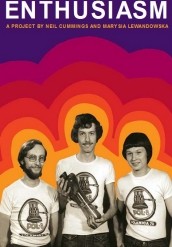
Cover of The Enthusiasts publication, courtesy Marysia Lewandowska
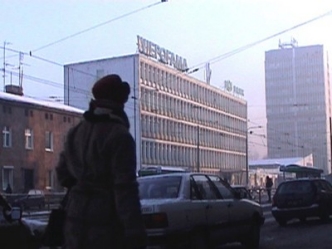
Still courtesy Marysia Lewandowska
Cultural and Political Context
There has been a spectacular transfiguration of Polish political and cultural life since the introduction of a market economy in 1989. In many ways, Poland is a crystallization of the forces at play in the rest of Europe. It projects a service-driven, consumer-led future while it is quite content to forget its industrial past and hide its manufacturing present. And yet, all the former state-owned industries still play a central role in the economic life of the country and are still relying on vast numbers of workers. Not only does industry manufacture the goods and energy necessary to generate our material lives through production and consumption, it also, classically, structures our social lives into “productive” work and nonproductive “leisure time,” understood as free time. Although by now, the emerging gray areas—between work and leisure—are obviously being blurred.
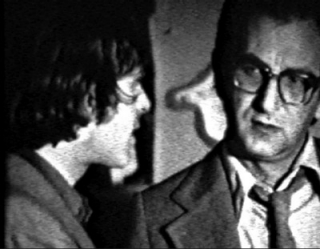
Krzysztof Kieślowski (R) during an AKF meeting,
image courtesy Marysia Lewandowska
A Chance Encounter
In Krzysztof Kieślowski’s first popular feature, Film Buff (Amator, 1979), the main character is a leading member of a factory film club. Kieślowski, along with other respected filmmakers, such as Krzysztof Zanussi, Wojciech Marczewski, and Agnieszka Holland, was a frequent judge at amateur film festivals. He used his experience, as well as that of “Klaps” film club members in Chybie in southwest Poland, as the basis for his film script, which he generated following the story of one of the club’s most active participants, Franek Dzida.
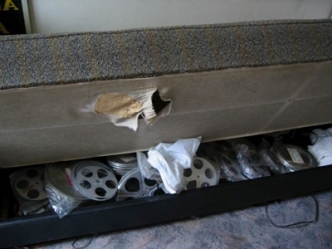
Research image courtesy Marysia Lewandowska
Research Trips
Out of this regulated network of work and leisure, perhaps the most popular clubs were those encouraging the making of amateur films. With 16 mm film stock, cameras, and editing tables supplied by the factory, around 300 clubs were created throughout Poland from the 1950s onward.
The space of the amateur, enthusiast, or hobbyist opens onto a range of interests and experiences generally invisible amongst the breathless flow of the state sponsored or the professionally mediated. The enthusiast is often working outside “official” culture and its products, frequently adopting a countercultural tone of tactical resistance and criticism. Many of these qualities can be ascribed to contemporary art practice.
As I mentioned earlier, the traditional model for representing the enthusiast is that work and leisure are locked in a binary opposition; the absence of one implicates the other. Work becomes the site of rational production, and in simple opposition, amateur pursuits become the location of all that is denied by wage labor: the space of happiness, desire, and enthusiasm.
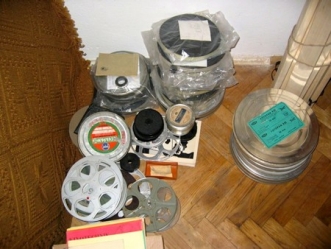
Research image courtesy Marysia Lewandowska
The film club enthusiasts often invert the logic of work and leisure, becoming truly productive when pursuing their passions, and using work for their own, rather than the factory’s or state’s, intentions. The film club members on a local level made a space for “themselves.” And this space functioned as a social club—these people were bound together by their passion for film. They watched and discussed foreign films in what looked like an “underground” network. They cleverly siphoned off film stock from “officially” sanctioned projects and used it to make their “own” films; all their productions emphasized the collaborative nature of scripting, acting, shooting, developing, and screening the films. So in one sense, these people were truly productive and truly creative in the time remaindered by labor, their “free time.” In many ways, the enthusiast records our forgotten past and prefigures our potential futures.
But what we experience right now is that this kind of enthusiasm—for all manner of activities—is what all political and economic systems are trying to harness for instrumental ends. The films both record and offer resistance to the deep structures of material life, which our political economy has evolved to administer. But it is clear, even to someone who did not live under socialism, that the ideas, emotions, and aspirations which find form in these films had no expression elsewhere. And in that sense, they offer alternatives, which have taken shape in mutual bonds of discussion and resistance. They act as inspiration for a more contemporary sense of collaborative practices. So, what is extraordinary about the films is that they represent the intimate experiences of people who themselves were caught up within these processes and relations. They are not official records or scenes staged for the professional media.
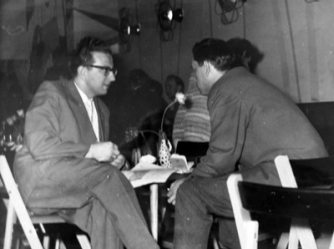
Image from an AKF meeting courtesy Marysia Lewandowska
The films made range from two-minute animations, short “experimental” and “abstract” films, documentaries on family, village, city, or factory life to historical dramas, “cowboy” films, features and ambitious mini “epics.” There is an astonishing range of material even though few films lasting more than 20 minutes because film stock was precious. The fact that simultaneous sound recording was technically difficult during this period is an unexpected bonus. Because of it, the themes or narratives unfold through extraordinary image sequences, occasionally using an added music sound track, often “borrowed” from radio or smuggled LPs. The films are, therefore, not dependent on the spoken word.
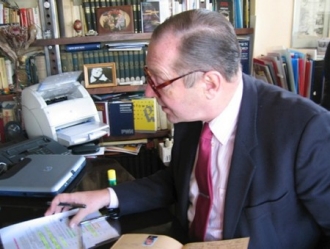
Research image courtesy Marysia Lewandowska
In Poland, the clubs, the members, and their films have been largely forgotten—tainted by their association with the previous political regime and because of their amateur status. This suggests a double repression. It seems they are undesirable, and as “the undesirables,” they lack representation. That is why all kinds of documentary-driven initiatives, many of them initiated by artists, should find support since they often help to identify similar areas of absence and marginalization.
Research connected to the Enthusiasm project fulfilled my desire as an artist to make visible, to expose, and to reflect on the conditions related to working-class production and the status of the amateur. As I remember, there has always existed a deep divide, even during the Communist time in Poland, between intellectuals and the working class, despite the propaganda that was designed to prove otherwise. The Enthusiasts project tries to enquire and open up some aspects of this divide. It also touches upon my personal history as someone who has been both educated under Communism and has also experienced the transformative power of art.
Both Neil and I were extremely aware of the ethical concerns in attempting to frame a practice of others, in this case factory workers, by taking a risk of misrepresentation. The process of negotiation and openness at every stage, from collecting the material to preparing the catalog, involved the filmmakers themselves. But it was also important that a sufficient trust in our own decisions be created and that they could relate to the project beyond its archival aspects. This was not an exercise in a final rehabilitation of their practice as producers under Communism. Our intention as artists was to rediscover the relevance of the social and political value of enthusiasm.
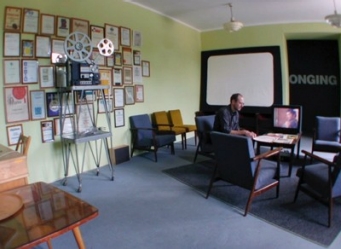
Installation image courtesy Marysia Lewandowska
The Exhibitions
In Warsaw, where the project was first launched in the summer of 2004, we worked closely with the Center for Contemporary Art at Ujazdowski Castle. For the Whitechapel Gallery in London, the project was substantially remade to provide another instance of the same material, which was necessary considering different expectations of the audience. In Poland, we explored the cultural context and were relying on local knowledge and experience. In London, we grounded the project in the phenomenon of enthusiasm as a cultural resource.
The exhibition adopted the tactic of “speculative quotation,” exploring by way of anthropology the presence of a “double repression” in contemporary social history. This “double repression” manifests itself first by the fact that all enthusiasts and their products are dominated by the image of the professional in all aspects of cultural life. Second, the places to which the clubs were attached—factories and industrial complexes—are being erased from our European consciousness and replaced with images of consumption, shopping, service economies, and communication. Part of our interest was related to the fact that it is enthusiasm, rather than labor, that offers a potentially unlimited source of capital. So the possibility that the filmmakers were truly productive in their leisure time is extremely relevant for us all now. In the spirit of collective activities which lay at the origin of the amateur film clubs, their importance in sustaining a reflexive and questioning position has found its present-time equivalent in Peer to Peer exchanges, Open Source Culture, and Creative Commons, the movements challenging conventional practices of authorship, ownership, and distribution of creative output.
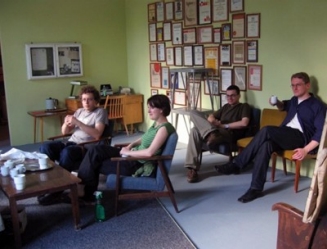
Installation image courtesy Marysia Lewandowska
While we worked with the filmmakers on digitizing their films, we also had begun negotiations for exhibiting and uploading their material under Creative Commons licenses. Many of them who are now approaching old age responded with interest. They recognized that by agreeing to place their films in an online archive, they are actively participating in the production of new knowledge, creating opportunity for others to interpret and reuse their creativity. This model offers a very different idea of heritage: not a safe haven full of hidden treasures but a live resource continually refreshed through use. This way the films could become a future source of creative work and not merely inert documents. In pursuing the creation of an archive of Polish amateur film, I want to emphasize the importance of democratizing this realm of imagery, which defines the past and constitutes a “public history,” and simultaneously to warn against its privatization. Collaboration always further complicates property relations, as the work bears names of many authors, so that the outcome cannot be easily appropriated inside well-established cultural institutions such as museums, which are still predominantly concerned with single authors and their “signature” creations.
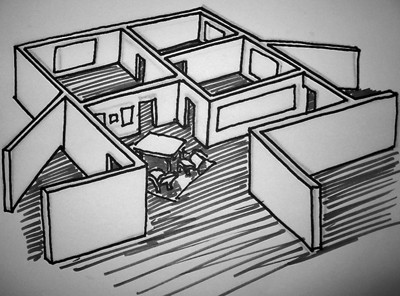
Exhibiiton design image courtesy Marysia Lewandowska
Exhibition Design
To represent the social activity at the heart of the project, we designed and built a fictional 1970s “club house.” Many of the clubs we have visited were extremely evocative spaces that bore witness to the social and creative history of the members through framed photographs, film stills, caricatures, medals and trophies, cupboards full of old film reels and video cassettes, redundant projectors, film editing desks, tea- and coffee-making equipment, a fridge, old video decks, a coat stand, odd chairs, and salvaged armchairs. In the exhibitions, the monitors found in this space play videos related to production “shoots,” meetings, and festivals, establishing the social nature of the clubs and the material context in which the films were made.
The filmmakers’ ambition was to make cinema (not home movies), and we respected this by trying to make the exhibitions a cinema-rich viewing experience. We believe that such conditions would add dignity to the filmmakers’ work, which is often treated as less valuable due to their amateur status. We were exhibiting not just the films but also the apparatus of cinema itself. This was particularly noticeable in the Whitechapel installation, where we collaborated with a London-based architectural practice called 51 percent. We jointly developed an idea where the three cinema spaces were constructed solely out of heavy velvet curtains with dimly lit entrances so evocative of cinema experience.
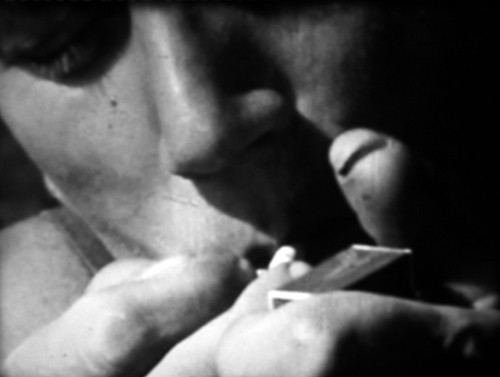
Still from Symbiosis, courtesy Marysia Lewandowska
For all the exhibitions, we curated by theme three separate film programs titled Love, Longing, and Labor, which run concurrently in three different “cinema” spaces. Love consists of films reflecting on the joy, banality, and celebration of “everyday” life; in this section, one finds babies, humor and camaraderie, parties, tactical resistance, and subversion. In Longing, we placed films of personal, political, and sexual nature, full of loss and longing. Here one finds themes of alienation, consumerism, orgies, ecological anxieties, complex emotional dramas, and political satire. The Labor program includes films that investigate and play with the various spaces of production, dignity of manual labour, satire on bureaucracy, critical animation on competition and politics, as well as the emptiness of work. The tension between Labor and the two remaining themes—between the public and the individual—defined the exhibition’s dynamic. It is a shift from a system of machine-based production to the individual and the production of subjectivity.
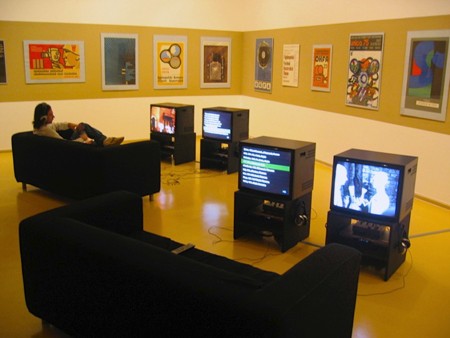
Installation image courtesy Marysia Lewandowska
We transferred as many films as possible into digital code, stored on DVDs. In the exhibition, they were made available in a separate Archive Lounge. The archive of films, as well as its setting, encouraged exhibition visitors to curate their own sequences of films—in effect, to make their own film program and to see what might be missing from our selection. By proposing what could be seen as more of a “performative archive,” we put into question the dominant way in which archival film material is often used by the entertainment industries of TV and cinema, as well as the traditional artistic treatment of found footage, which entails fragmenting the material, stripping it of historical context, and reducing it to what could be seen as film footnotes. The film archives relating to the years 1945–1989 in Poland are currently managed according to a corporate logic instead of being open and publicly available. It is almost impossible to gain access to the films from this period for research or artistic purposes. Needless to say, none of the films we recovered can be found in such archives.
The project as a whole was committed to restoring public awareness of previously marginalized material. One of the imperatives in pursuing this kind of collaboration with the filmmakers was to reconsider and re-evaluate a perceived position of weakness—a position associated with the figure of the amateur and enthusiast—and to provide a platform, or possibly act as a conduit, for dissemination without judgment. The more we researched the remnants and ruins of this vast movement, the more we were struck by the fact that a whole class of people/workers and their sophisticated production lost its cultural urgency in one sweep of historical change. The newly embraced market economy helped to drown the values engendered by Communism that once nourished such production.
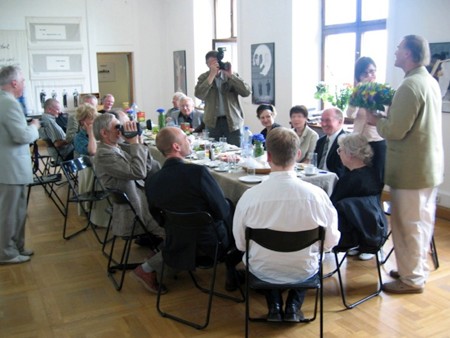
Image courtesy Marysia Lewandowska
What so clearly emerged for us, however, from our encounters with the filmmakers we met and with their films was a powerful example of taking matters into their own hands. Matters that mattered to them individually but which through consistent representation also affected the minds of others. Escaping propaganda pressures, they were learning the skills of negotiation through collective efforts of filmmaking. Their strategies of nonconformism, of disguise, a precarious position between the conditions dictated by state patronage and a desire for political freedom, find expression in many of the films. What we were inspired by was an emergence of ambitious individuals who organized themselves in order to create films about their own realities: a “grassroots” energy that redefines relations between culture and everyday practice.
Consequently, what we were keen to imagine was a space which could serve as a relevant conceptual arena, reflecting and extending their ideas of collaboration and sharing. This kind of approach can be found in the Free Culture movement, whose mission is to build a bottom-up, participatory structure for society and culture, rather than a top-down, enclosed, proprietary system. Through the democratizing power of digital technology and the Internet, we can place the tools of creation and distribution, communication and collaboration, teaching and learning in the hands of the common person. And this is not at the expense of losing our own identities and differences. In a gesture of reciprocity, we have placed the films we recovered in an online archive. The Enthusiasts Archive will be available in the future through a newly established website as part of the film collection of the Museum of Modern Art in Warsaw.
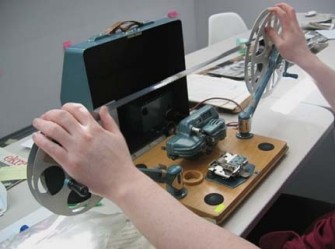
16 mm editing table, image courtesy Marysia Lewandowska
I would like to end with a fragment of a conversation with one of the filmmakers, Franek Dzida from Chybie, where in 1969 he established an amateur film club called “Klaps.” This is what he said in Polish in August 2002, which I have translated for the Enthusiasts catalog: “I’ve been ‘touched’ by the magic of cinema. When my military service in Szczecin finished and I qualified as a cinema operator, I obtained access to a projector and films. I used to screen more ambitious films. I felt a need to talk about films and to analyze them and started looking for listeners and partners. I was employed as a technician in the sugar factory. Around me were metal-workers and electricians. I proposed setting up a film club in the factory. This was to become our window onto the world and to allow us to break away from our provincial world, from this small-town mentality. At the time, I felt a great affinity with Bergman. It was only that he was able to work with different film stock and different funds. But other than that, we were both part of the same film community, we shared the same passion for film. I needed it immensely, not because I felt oppressed by the system, everybody could find a way to get round it. (He laughs.) But it gave you a chance to mark your presence. Being an artist was one way of marking such presence. It felt like a great distinction and honor. Today everyone is an artist, so you have to look really hard to find those who really mean it.”
